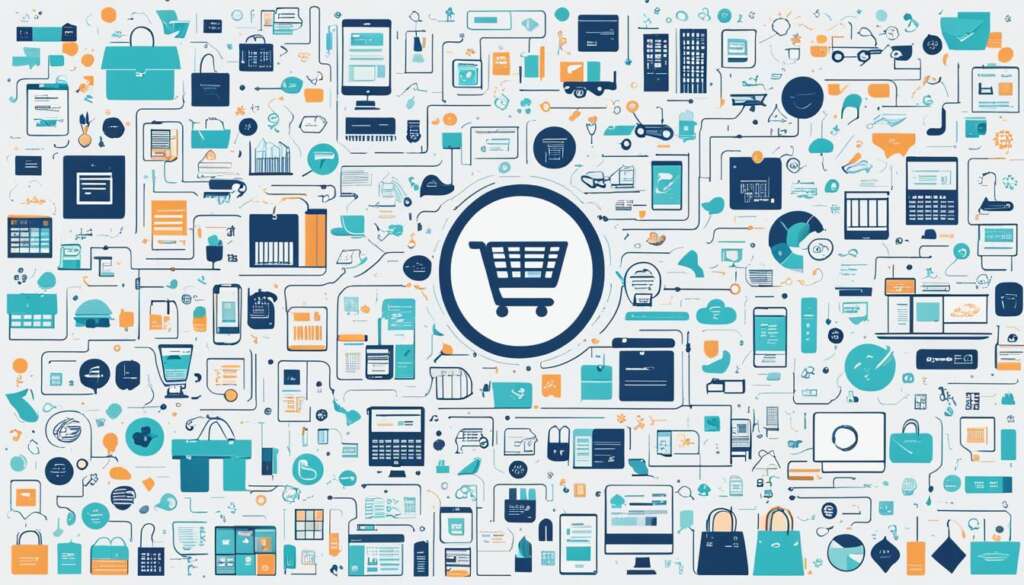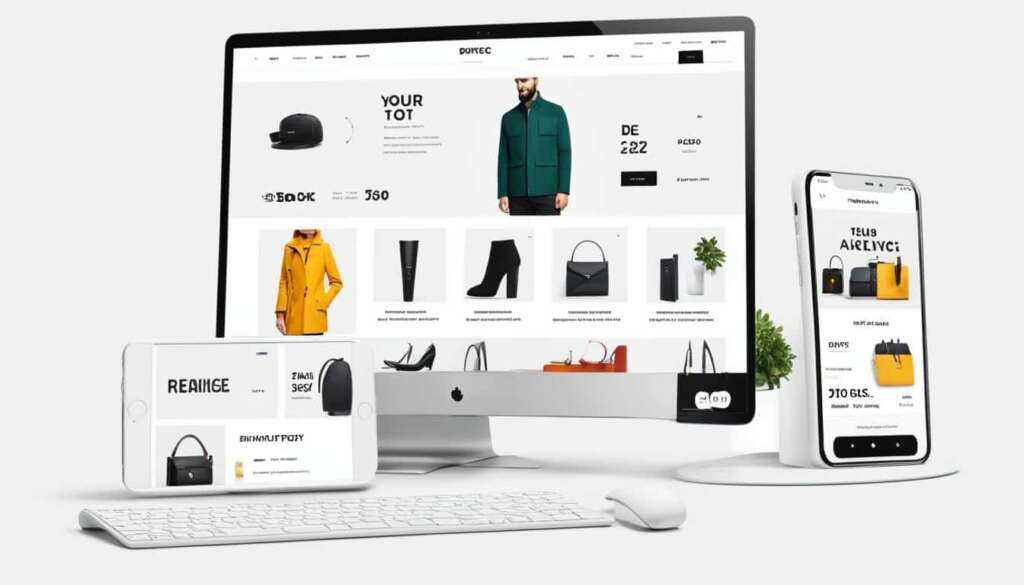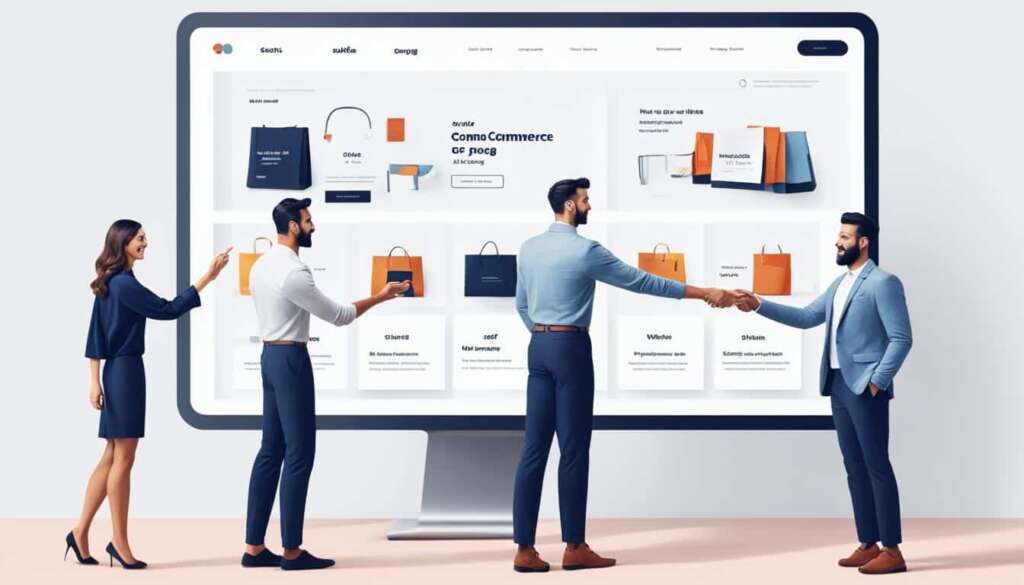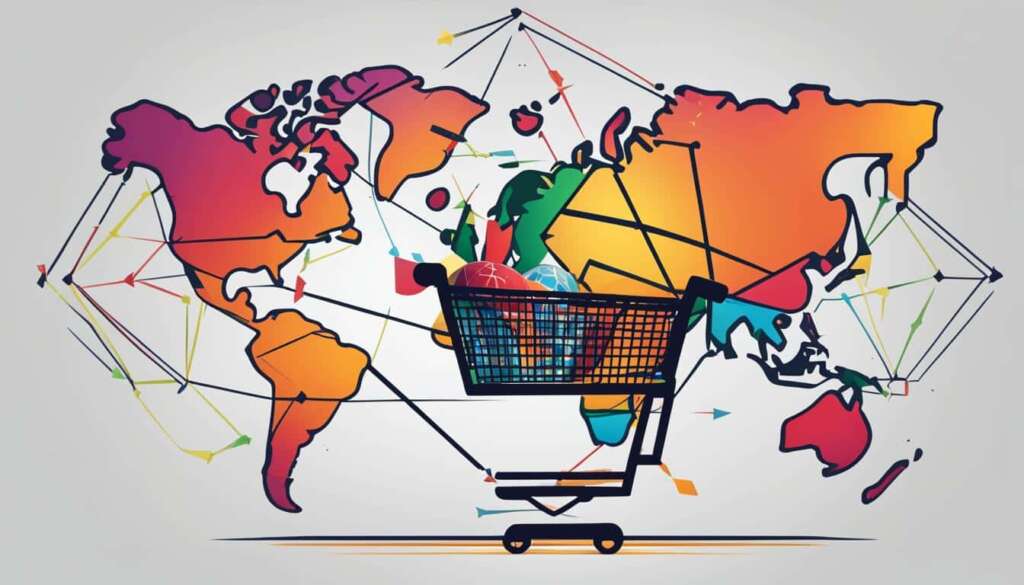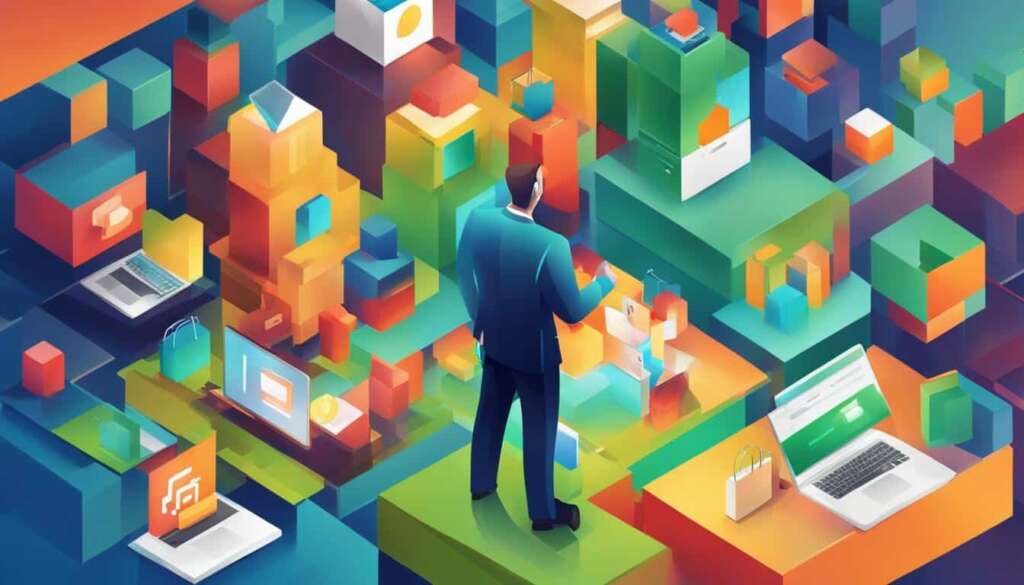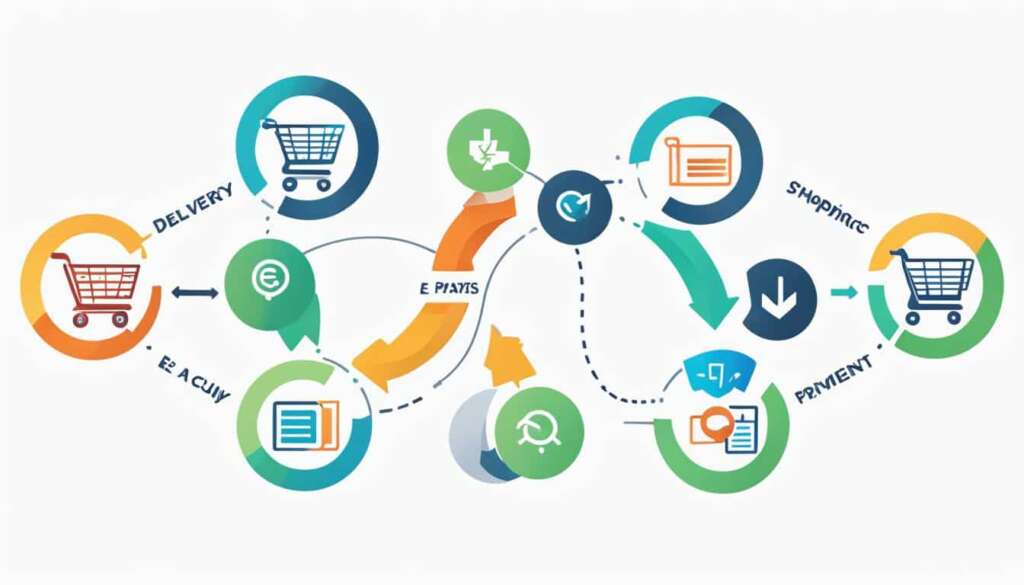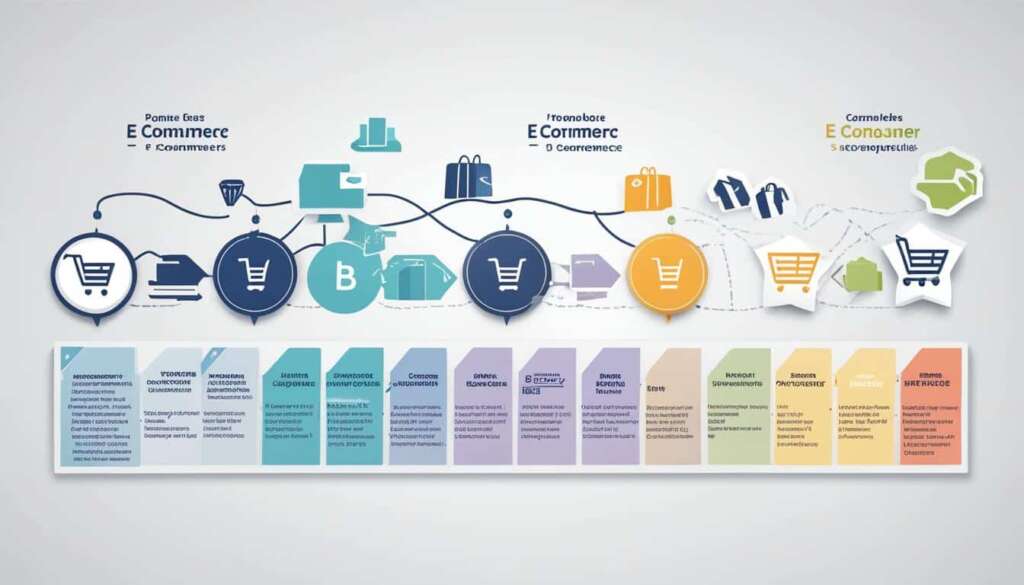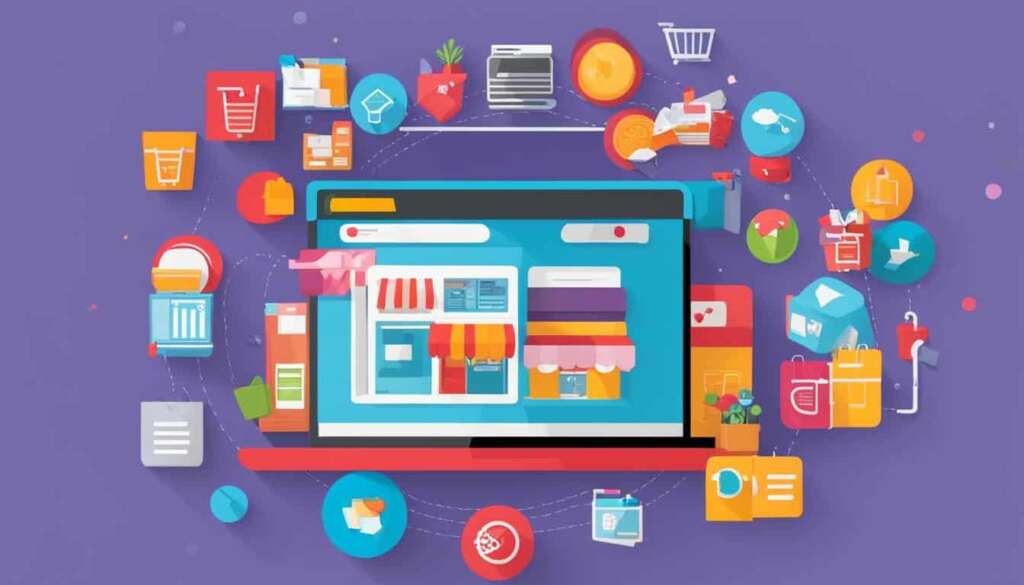Table of Contents
E-commerce has become an integral part of global retail, accounting for around 20% of overall sales. In this digital landscape, understanding the various e-commerce types, models, and structures is vital for success. Let’s delve into the six major e-commerce business models that drive the online marketplace.
The first model we’ll explore is Business to Consumer (B2C). This model involves businesses directly marketing their products or services to end consumers. Whether it’s direct-to-consumer brands, online intermediaries, or advertising-based models, B2C e-commerce strives to reach customers where they prefer to shop. Brick-and-mortar retailers have also embraced this model by adopting an omnichannel e-commerce strategy.
Next, we have Business to Business (B2B) e-commerce. In this model, companies market their offerings directly to other businesses. B2B can be vertically oriented, targeting customers within specific industries, or horizontally oriented, serving customers across multiple industries. B2B brands are increasingly focusing on e-commerce to meet consumer demands, with B2B digital commerce initiatives surpassing B2C. By 2025, it’s estimated that 75% of B2B manufacturers will sell directly to customers via digital channels.
Another important model is Business to Government (B2G). Here, companies market their products and services to government agencies at various levels. B2G transactions often involve bidding on government contracts when agencies announce requests for proposals (RFPs). While this sector may have more bureaucratic processes, it offers unique opportunities for businesses to collaborate with the government.
The Business to Business to Consumer (B2B2C) model involves one business selling to another business, which then sells to the end consumer. This model offers collaboration opportunities between businesses to promote products and services or acquire customers rapidly. By leveraging partnerships, businesses can expand their reach and increase their customer base.
With the Consumer to Business (C2B) model, individuals can now sell goods and services directly to companies. Platforms like Upwork connect organizations with individuals offering specific skills or services. C2B also includes influencer marketing, where individuals collaborate with businesses for promotional purposes, giving consumers the power to set their prices or have businesses compete to meet their needs.
In conclusion, understanding the different e-commerce models is crucial for businesses seeking to thrive in the digital landscape. Whether it’s B2C, B2B, B2G, B2B2C, C2B, or even Consumer to Consumer (C2C), each model has its unique characteristics and considerations. Businesses must evaluate their target market, products/services, and goals to determine the most suitable e-commerce model and devise a well-planned e-commerce strategy for success.
E-commerce Business Models: Business to Consumer (B2C)
The B2C e-commerce business model plays a vital role in today’s digital landscape. It involves companies marketing their products or services directly to end users. This model allows businesses to establish a direct connection with consumers, reaching them where they shop and making transactions convenient and efficient.
Under the B2C umbrella, there are several subsets that enable companies to target consumers through various strategies and platforms, including:
- DTC e-commerce: Companies sell their products or services directly to consumers through their own online store, bypassing traditional retail channels.
- Online intermediaries: Platforms or marketplaces serve as intermediaries, connecting businesses with consumers looking for specific products or services.
- Advertising-based models: Companies monetize their online presence by generating revenue through advertising, such as display ads or sponsored content.
- Community-based sites: Online communities or social networking platforms provide a space for consumers to interact, share reviews, and make purchases.
- Fee-based models: Membership or subscription-based platforms offer exclusive access or benefits to consumers for a recurring fee.
In today’s digital world, many traditional brick-and-mortar retailers have recognized the importance of integrating digital channels into their business strategies. To stay competitive and meet consumer demands, these retailers have adopted an omnichannel e-commerce approach. This approach combines physical stores with online platforms, allowing consumers to seamlessly browse and purchase products through multiple channels, such as websites, mobile apps, and social media.
“The B2C e-commerce model opens up endless possibilities for businesses to directly engage with their target consumers, build brand loyalty, and provide personalized experiences.”
E-commerce Business Models: Business to Business (B2B)
The B2B e-commerce business model involves companies marketing their products or services directly to other businesses. It can be vertically oriented, selling to customers within a specific industry, or horizontally oriented, selling to customers across many industries.
B2B brands have increasingly focused on e-commerce to keep up with consumer demands, with B2B digital commerce initiatives surpassing B2C. By 2025, it is estimated that 75% of B2B manufacturers will sell directly to customers via digital commerce.
| Advantages of B2B E-commerce | Challenges of B2B E-commerce |
|---|---|
| Increased efficiency in procurement processes | Complexity in managing a large volume of transactions |
| Expanded global reach and access to new markets | Integration and compatibility issues between different systems |
| Improved customer service through personalized experiences | Ensuring data security and privacy |
The Advantages of B2B E-commerce
- Increased efficiency in procurement processes.
- Expanded global reach and access to new markets.
- Improved customer service through personalized experiences.
The Challenges of B2B E-commerce
- Complexity in managing a large volume of transactions.
- Integration and compatibility issues between different systems.
- Ensuring data security and privacy.
By embracing B2B e-commerce, businesses can streamline their operations, reach a wider audience, and provide a seamless experience for their customers. However, they must also address the unique challenges associated with running a B2B e-commerce platform.
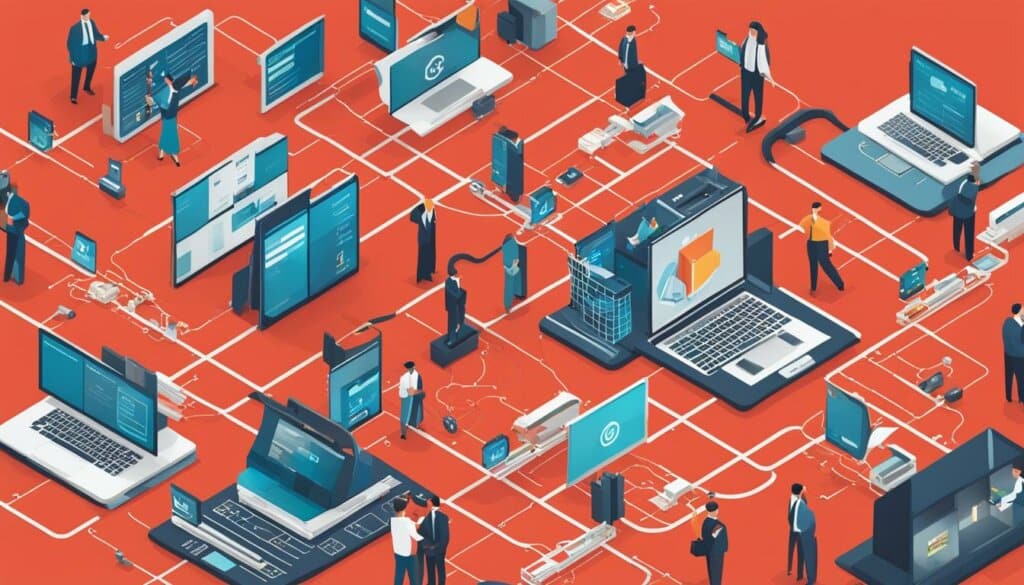
The B2B e-commerce model offers numerous opportunities for businesses looking to establish direct relationships with other companies. As digital commerce continues to evolve, B2B brands must adapt and leverage technology to stay competitive in the ever-changing business landscape.
E-commerce Business Models: Business to Government (B2G)
The B2G e-commerce business model involves companies marketing their products and services directly to government agencies at the local, county, state, or federal level. This model opens up opportunities for businesses to cater to the unique demands of the government sector.
One of the primary ways B2G transactions occur is through the bidding process on government contracts. When government agencies announce requests for proposals (RFPs), companies can submit their bids to secure contracts for supplying goods or services. These contracts can range from infrastructure projects to technological solutions.
Interacting with government agencies in the B2G e-commerce model can present challenges compared to other sectors. The government procurement process tends to be slower and more bureaucratic, involving various stages such as needs analysis, document submission, evaluation, and contract negotiation. Businesses operating in the B2G space need to have patience and a thorough understanding of the government’s policies and procedures.
The B2G e-commerce model offers several advantages to both businesses and government agencies. For businesses, it provides opportunities to secure long-term contracts and stable revenue streams. Government agencies can leverage the expertise and innovations of private companies to fulfill their requirements efficiently.
“The B2G e-commerce model enables government agencies to access a wide range of products and services from private companies, ensuring value for taxpayers’ money while supporting economic growth.” – Government Procurement Officer
Businesses looking to engage in B2G e-commerce should be prepared to meet specific requirements set by government agencies, such as compliance with regulations and certifications. Understanding the procurement landscape and building strong relationships with government decision-makers are also essential for success in this model.
Benefits of the B2G E-Commerce Model:
- Opportunities for long-term contracts
- Stable revenue streams
- Access to a wider customer base
- Supporting government initiatives and public services
- Driving economic growth and innovation
While the B2G e-commerce model may involve additional complexities compared to other models, businesses that successfully navigate the government procurement process can tap into a lucrative market and contribute to the public sector’s needs.
| Pros | Cons |
|---|---|
| Opportunities for long-term contracts | Slower and more bureaucratic procurement process |
| Stable revenue streams | Strict compliance requirements |
| Access to a wider customer base | Complex regulations and certifications |
| Supporting government initiatives and public services | Requires understanding of government policies and procedures |
| Driving economic growth and innovation | Competition from other businesses in the bidding process |
E-commerce Business Models: Business to Business to Consumer (B2B2C)
The B2B2C e-commerce business model is a strategic approach where one business sells products or services to another company, which then sells to the end user or consumer. This model involves three main actors: the business of product origin, an intermediary, and the consumer. It can be utilized in various ways to unlock new avenues of growth and customer acquisition.
In a B2B2C setup, the business of product origin forms partnerships with intermediate companies to reach a broader consumer base or promote their offerings. By leveraging these intermediaries, businesses can tap into new markets, expand their distribution channels, and enhance brand visibility. This model also enables companies to establish mutually beneficial relationships, resulting in increased sales and exposure for both parties involved.
One common example of B2B2C e-commerce is when a manufacturer sells its products to a retailer, such as an online marketplace or a physical store, which then sells the products directly to consumers. This enables manufacturers to focus on production and innovation while relying on intermediaries to handle marketing, distribution, and customer service.
In B2B2C e-commerce, the role of the intermediary is crucial, as they act as the bridge connecting the business of product origin and the end consumer. These intermediaries may be online marketplaces, wholesalers, retailers, or even influencers who promote and sell products or services on behalf of the originating business.
By incorporating the B2B2C e-commerce model into their strategies, businesses can benefit from shared resources, reduced costs, and increased market reach. Additionally, it allows them to leverage the expertise and established customer base of the intermediaries to gain a competitive edge.
A visually engaging table highlighting the key advantages and considerations of the B2B2C e-commerce business model:
| Advantages of B2B2C Model | Considerations of B2B2C Model |
|---|---|
|
|
By carefully evaluating the benefits and considerations of the B2B2C e-commerce model, businesses can make informed decisions and develop strategies that align with their goals and target audience. Embracing this collaborative approach can pave the way for accelerated growth, enhanced customer experiences, and sustained success in the ever-evolving digital landscape.
E-commerce Business Models: Consumer to Business (C2B)
The C2B e-commerce business model is revolutionizing the way individuals interact with companies in the digital age. Unlike traditional business models where companies market their products or services to consumers, the C2B model empowers individuals to sell their goods and services directly to businesses.
One popular platform that embodies the C2B model is Upwork. Upwork connects organizations with individuals who offer specific skills or services, such as graphic design, writing, programming, and more. This allows individuals to showcase their expertise and directly market themselves to potential clients.
What sets the C2B model apart is the power it gives consumers. Instead of businesses dictating prices and offerings, C2B allows individuals to set their own prices and have businesses compete to meet their needs. This consumer-centric approach puts the control back in the hands of individuals, allowing them to leverage their skills and negotiate favorable terms.
“The C2B model disrupts traditional business norms by allowing individuals to monetize their skills and expertise, providing an alternative route for income generation.”
In addition to platforms like Upwork, influencer marketing is another example of the C2B model. Influencers, who have built a significant online following, connect with businesses to promote their products or services. This type of collaboration showcases the value of individuals in driving business growth through their personal brand and influence.
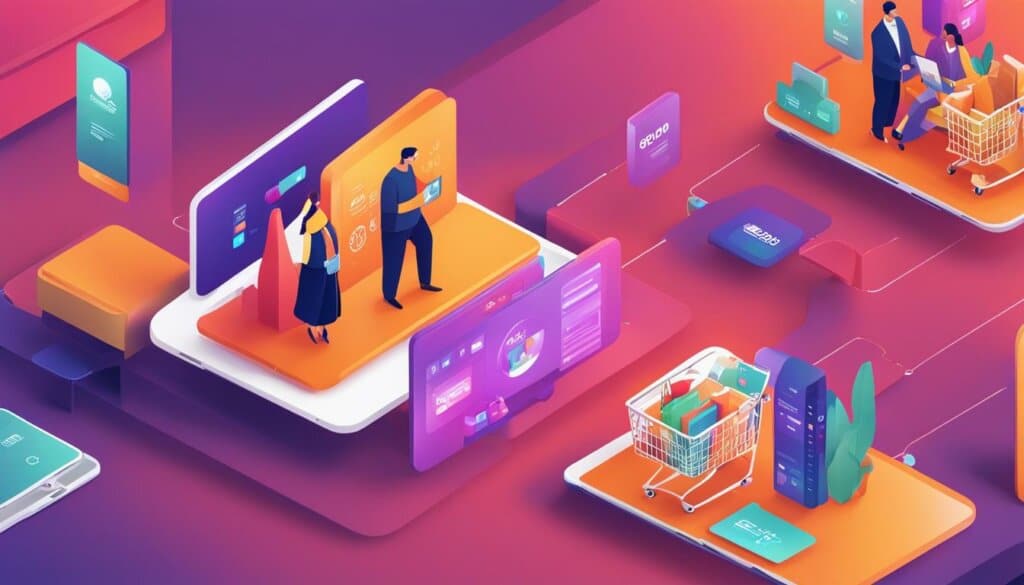
The Benefits of the C2B Model
- Flexibility and Independence: The C2B model allows individuals to work on their own terms, choosing the projects they are passionate about and setting their own prices.
- Increased Income Potential: By directly marketing their skills, individuals have the potential to earn more than they would in traditional employment.
- Opportunity to Showcase Expertise: C2B platforms provide individuals with a platform to demonstrate their skills and expertise, building their personal brand and reputation.
- Direct Engagement with Businesses: The C2B model enables direct communication and collaboration between individuals and businesses, fostering valuable relationships and networking opportunities.
The C2B e-commerce business model offers exciting opportunities for individuals to monetize their skills and expertise, while also providing businesses with access to a diverse pool of talent. With the continued growth of digital platforms and the increasing demand for personalized services, the C2B model is expected to thrive and reshape the e-commerce landscape.
Conclusion
Understanding the different e-commerce business models is crucial for success in the digital landscape. Whether it’s B2C, B2B, B2G, B2B2C, C2B, or C2C, each model has its own unique characteristics and considerations.
Businesses must evaluate their target market, products and services, and goals to determine the most suitable e-commerce model. By choosing the right model, businesses can effectively reach their desired audience and cater to their specific needs.
The shift to digital is undeniable, and having a well-planned e-commerce business strategy is essential for driving traffic, generating revenue, and maximizing return on investment (ROI). Embracing e-commerce allows businesses to expand their reach, connect with customers around the clock, and stay competitive in today’s fast-paced digital world.
FAQ
What are the different e-commerce business models?
The different e-commerce business models include Business to Consumer (B2C), Business to Business (B2B), Business to Government (B2G), Business to Business to Consumer (B2B2C), Consumer to Business (C2B), and Consumer to Consumer (C2C).
What is the B2C e-commerce business model?
The B2C e-commerce model involves companies marketing their products or services directly to end users. This model includes subsets such as DTC e-commerce, online intermediaries, advertising-based models, community-based sites, and fee-based models.
What is the B2B e-commerce business model?
The B2B e-commerce model is when a company markets its products or services directly to other businesses. It can be vertically oriented, selling to customers within a specific industry, or horizontally oriented, selling to customers across many industries.
What is the B2G e-commerce business model?
The B2G e-commerce model involves companies marketing their products and services directly to government agencies at the local, county, state, or federal level. B2G transactions typically occur through the bidding on government contracts when agencies announce requests for proposals (RFPs).
What is the B2B2C e-commerce business model?
The B2B2C e-commerce model is when one business sells products or services to another company, which then sells to a consumer. This model involves three actors: the business of product origin, an intermediary, and the end user or consumer.
What is the C2B e-commerce business model?
The C2B e-commerce model allows individuals to sell goods and services directly to companies. Platforms like Upwork connect organizations with individuals offering specific skills or services. Influencer marketing platforms are also examples of C2B e-commerce, connecting individuals with businesses for promotional purposes.

